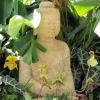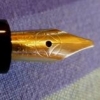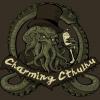Search the Community
Showing results for tags 'brown'.
-
There are four KWZ inks having "brown" in their name: Brown #2, Brown #3, Brown #4 (this ink), and Dark Brown. These are the warm browns, the red-leaning ones, that some people don't like. That's not an issue for me so long as it's a nice color, and the handling is how I like it in my pens. Each has their own qualities in handling and appearance, however, only one of them, #3, is actually a brown to my eyes. With this preview out of the way, let's look at the individual inks. While the color of this ink is not quite brown, it's a very good color. I think visvamitra likened it to "baked cherry" in his 2015 review. It definitely has a "yummy-ness" to it, in color richness and in wetness. You might want to check out that review for the color accuracy as my images came out too dark and his look very good, as well as Cyber6's listing of all the KWZ inks (link below). visvamitra's review.https://www.fountainpennetwork.com/forum/topic/295605-brown-no-4-baked-cherry-kwzi/?p=3434898 Cyber6's full KWZI list:https://www.fountainpennetwork.com/forum/topic/280869-kwzi-full-list-may-2015/?p=3215166 The usual papers: MvL=Mohawk via Linen, Hij=Hammermill 28 lb inkjet, TR=Tomoe River. The photo definitely shows this as too dark. Much more moderate and deep red. Still to dark... Imagine this being deep dark red and you've got it. Yes, red. Not terribly water resistant, but the standard inks aren't meant to be so.
-
FPN Community, I need your experience and suggestions. Background: I posted a question elsewhere on FPN about my difficulty finding paper onto which I could print high-res photos AND then handwrite messages with fountain pens. Everything feathers so much you can't really tell what nib formed the letters. Some letterforms are obliterated on the Strathmore I'd like to use for its careful marriage of envelope and card stock. It was suggested that iron gall inks would behave better on papers necessary to the color reproduction.I had no experience with iron gall inks; after reading/viewing reviews here and elsewhere I bought a bottle of KWZ Mandarin from Vanness. I observed in review after review Mandarin's change from a bright orange to a shaded brown with a *hint* of orange or red. This was the result I wanted. There are 170 mentions of Mandarin KWZ in this one forum alone. Google Image has lots more. Yes, I saw some samples that moved way further toward a toned-down brown. I also saw that there was a range to the formulations that came out of Poland. "The batches are hand-made," one person wrote somewhere on the Internet. I am posting an image of what my batch looks like. The patch on the bottle label is perfect! I am surprised at how little color I see. It's grey, not brown. At the moment it comes through the nib it's this same grey-brown. There is no color shift! It also feathers on a slightly coated 100lb cover stock I get from a local printer to allow me to take quick notes. I picked this stock for the ability to hold ink from a nib and not feather. I wrote a comparison sentence on the card. I hope the image will post in this query successfully... that worked. On my monitor there's more color in the Mandarin in this attached image file than I experience in the actual sample. (I'm a commercial photographer... used to looking at how colors are changed by digital work flows.) I am not expecting the Mandarin to look like the Ancient Copper. What do you folks think? In range? Too grey? Do iron gall inks feather more - or less - or "it depends"?
-
As soon as I discovered the original M800 Brown Tortoise, it was my favorite Pelikan and THE end game to my fountain pen acquirement to own one someday. Of course at that point it was just a pipe dream. It was practically semi-mythical and sold for over $2000 on the rare occasions it might surface. There was no way I would spend that kind of money on a pen on principle. So like many others I held on to the great hope that Pelikan would one day decide to produce it again and our collective dream was fulfilled, though not exactly as we'd hoped. Nevertheless, I saved up for it and once I had the funds ready, I waited. For nearly a year. I had the money, I knew what nib I wanted and which seller I could buy it most cheaply from, but for some reason I just kept waiting. I watched others post wonderful reviews of the pen, most notably this recently revived thread from FPN member Niagara Falls. There I saw the M400 Brown Tortoise and decided that it, along with the M800 Brown Tortoise would be my ultimate Pelikan mini collection. Eventually. It was long discontinued and I didn't expect to come across a M400 Brown Tortoise any time soon. Then last week I finally made up my mind to buy the new M800. I was going to buy it from ebay, but for some reason decided to browse Regina Martini's auction site first. I saw the M400, and I snapped it up. I had spent months prevaricating with the last pen I'd bought, and nearly a year with the M800, and yet in the span of a few minutes I'd purchased the M400. I probably spent too much on it, but I don't even have a hint of buyer's remorse. It hasn't arrived yet though, so maybe that will change. This is one of the best pictures I've found of the pen. All credits to this Japanese blog entry from 2012. I had been under the impression that the particular M400 Brown Tortoise I bought was exlcusive to the Galeria Kaufhof and had been in limited production. Regina told me that it was not a limited or special edition of any sort, nor was it exclusive to any retailer, but for some reason ended up being produced for only a short time. Regina also added that the tortoise color on this binde is the same as the original M800 tortoise, so that's nice. I'd like to get more information on the M400 Brown Tortoise. When was it produced? Was it just a regular M400, or actually a special edition like the white tortoise is? Do members around here own this pen? How do you like it? It'll be here any day now. I'm so excited!
-
For the last couple years KWZ and BauerInks.ca have collaborated in producing an ink for the Scriptus Pen Show in Toronto, Ontario, Canada. 2015 was Maple Leaf Red. 2016 resulted in the fabulous Northern Twilight. 2017 produced an ink commemorating the 150th anniversary of the Canadian Confederation. There were many homages to this event, usually in precious things you could buy, such as commemorative currency, stamps, etc. For Scriptus, it was an ink. A brown ink. Or maybe it's a green ink that wants to be a brown ink. Or maybe the reverse, green that wants to be brown. For this reason alone the ink could be divisive. The ink has decent flow, and OK lubrication. This particular nib was originally quite problematic, but was worked on my Linda Kennedy of Indy-Pen-Dance to "Binderize" it. It writes much more smoothly now, but some inks can bring out a less smooth writing experience. The 150th shows much more feedback than some other inks. But it's not outside a normal range of expectations. I do get some hard starts when left uncapped for 15 seconds or so. Not very hard, but you lose part of a stroke. It's not as much of a problem as I have with KWZ Baltic Memories at all, just a minor issue. I'm still trying to decide if I like the ink: I think the answer is leaning towards yes. The Tomoe River image is very good as a representation of the ink showing it's green side. Depending upon the light it can appear more brown or more green. Both MvL images are too dark, but they show the brown side with a bias to the green. The Rhodia images, while a little dark shows the color on it's green side, which is what I see on the paper. I admit when I first started using the ink last night under artificial lighting the ink didn't seem very interesting. But the same things I wrote last night now appear more brownish-greenish, and more interesting. I know the light is natural now. So will I see things as more green at night? I don't know. As I mentioned in another thread some will call the color "fallen leaf brown" and others "pond scum green". Where you fall on that scale probably will determine whether you'll like the color or not. When placed against a brown ink it definitely appears greenish, and when compared to a green ink, it appears brownish. In value it is similar to many other green inks in middle range. It is not dark like KWZ Midnight Green. The ink is not waterproof and not water resistant. So if that's an important criteria for you, exercise caution, or buy permanent inks. I'll have to post the water resistance test and the simple chromatography images later, after they dry. This ink was limited edition for the Scriptus 2017 pen show. Bauerinks.ca purchased the remainders of what didn't sell at the show. I don't know if there are any bottles left, but they ask interested parties to make an inquiry. I think the biggest issue for those outside Canada will be shipping charges since mailing inks apparently is more expensive there. Pen: Edison Mina (M-steel) Papers: MvL=Mohawk via Linen, TR=Tomoe River, Hij=Hammermill 28 lb inkjet, Rhodia=Rhodia 90g ivory. Camera: iPhone 7 using Camera+ app
-
Greetings All, There are some good lists of inks safe for vintage pens scattered throughout the forums, but I haven't seen any sepias specifically mentioned. I'm in the market for a vintage flex and would like my writing to have an old-timey feel. I'm hoping we can put together a list of sepia inks (including anything broadly defined as such according to one's own taste) that are vintage pen friendly. I don't mean high-maintenance inks that require utmost pen hygiene, but those you can leave in the pen for a couple weeks without having to worry about corrosion or clogging. Water-resistance is also a plus, but not essential. Staining also isn't much of an issue since vintage pens aren't usually demonstrators anyway. Any recommendarionaations are greatly appreciated!
-
Ink Review : Diamine Bach (Music Collection) Pen: Lamy AL-star, M-nib Paper: Rhodia N°16 notepad 90 gsm Leipzig, a late afternoon in November 1726“I have left the busy city for a quiet walk in the woods. It’s cold and dark and somber – the gloomy mood intensified by the dark brown towering oaks that resemble an open-air cathedral. This setting inspires my muse. I hear in my mind a grand baroque piece commemorating the Death of Christ, ideally suited for a performance in my beloved St Thomas Church (Thomaskirche). I think I will name it the Matthäeus-Passion.” In 2015 Diamine released the Music Collection, a set of 10 subdued ink colours named after well-known composers. In this review, we take a look at Bach. After the above introduction, you're sure to remember that this is a dark-brown ink. Diamine Bach is a dark-brown ink, which to my eye is close to a true brown, with very little red in the undertones. This is also evident from the chromatography. Bach is a well lubricated ink with excellent contrast to the paper. An ink that easily tolerates even the finest nibs. With broader nibs, it starts to show some really nice subdued shading, without too much contrast between the light and darker parts of the text. Nicely done! The ink behaved perfectly on all the papers I tested – with only a touch of bleed-through on the notoriously bad Moleskine paper. Drying times are mostly in the 10-15 second range, but tend to increase on more glossy paper (all with M-nib). The ink’s look & feel is fairly consistent across paper types, and the result looks good on both white and more yellow paper. The ink has no water resistance to speak of – even short exposure to water will obliterate your writing. Technically a very good ink, but for some reason it fails to speak to me. I tried to like it… but nope… didn’t work. I’m sure though that there are others out there that will appreciate this incarnation of brown. Inkxperiment – Heron at a PondI’ve recently started to experiment with ink drawings, keeping things simple and more-or-less abstract. I find it to be a fun extension of the hobby, and have found single-ink drawings a nice challenge. It also gives you an idea of what the ink is capable of in a more artistic setting. For this drawing I used 90 gsm sketch paper. I used a piece of cardboard dipped in ink to create the background together with the trees. For the pond I applied ink with a dip pen, and used a water brush to spread it out. I then added in the heron and the rest of the plants. The end result gives you a good idea of the colour span that Bach is capable of (which is limited – Bach is more at home as a writing ink). ConclusionDiamine Bach is a nice dark-brown writing ink that works well with any combination of nib and paper. The ink has a limited colour range though, which makes it less suited for drawing. Also of note is its complete lack of water resistance. Bach is technically an excellent ink, but I find it hard to get excited about it. A decent ink, but – for me personally – not a keeper. My overall score : B Technical test results on Rhodia N°16 notepad paper using a Lamy Safari
-
- 11 replies
-
- deatramentis
- ebony
-
(and 5 more)
Tagged with:
-
- 3 replies
-
- lartisan pastellier
- callifolio
-
(and 8 more)
Tagged with:
-
- 9 replies
-
- j herbin
- lie de the
-
(and 3 more)
Tagged with:
-
- 7 replies
-
- noodlers
- rome burning
- (and 8 more)
-
- 11 replies
-
- robert oster
- green olive
-
(and 8 more)
Tagged with:
-
- 4 replies
-
- iroshizuku
- ina-ho
- (and 6 more)
-
- 9 replies
-
- kyo no oto
- kyonooto
-
(and 8 more)
Tagged with:
-
There's a pen/stationary store in Japan named Engeika, or something like that. They have a small line of inks under their own brand "Wancher". Like some others I received a sample of a new color Chocolate. visvamitra recently reviewed it as well. This isn't a bad ink at all, but not anything special. It has a milk chocolate kind of look to it that didn't get captured by the images. It has some water resistance which surprised me. It's not like Noodler's water resistant or waterproof inks, though the image looks good some ink was lost. The dye composition of the ink is interesting: purple, green, turquoise. On Tomoe River there was some drying problems with punctuation; even after several minutes, they'd still smear. I hadn't really encountered that before. No staining on the pen in the ink window. So if you are in Japan, or ordering from this shop, it may be worth giving the ink a try as it's not that expensive. But I'm not sure whether it's worth it to go out of your way to get some. Pen: Pelikan M200 (M-steel) Papers: MvL=Mohawk via Linen, TR=Tomoe River, Hij=Hammermill 28 lb inkjet, Rhodia=Rhodia 90g ivory. Camera: iPhone 7
-
-
L'Artisan Pastellier Callifolio - Itzamna L’Artisan Pastellier is a small company in southern France that specialises in natural pigments, and offers customers authentic and reliable products in beautiful colours based on mineral or vegetable pigments. In a collaboration with Loic Rainouard from Styloplume.net, the chemist Didier Boinnard from L’Artisan Pastellier created the line of Callifolio fountain pen inks. These pastel-coloured inks are traditionally crafted, and can be freely mixed and matched. Overall these inks are only moderately saturated, and have low water-resistance. The inks were specifically designed to work well with all types of paper, and all types of fountain pens. Being pastel-tinted, these inks have a watercolour-like appearance, and are not only fine inks for journaling, but are also really excellent inks for doodling & drawing. I only recently discovered them, and they are already the inks I gravitate towards for personal journaling. In this review I take a closer look at Itzamna, one of several ochre-coloured inks in the Callifolio series. In Maya mythology, Itzamna is the name of an upper god and creator deity thought to reside in the sky. An interesting name for a fountain pen ink – let’s see whether the ink is as great as its name suggests. I started with my usual Lamy Safari pens (M and B nib), which are fairly dry writers – with these pens Itzamna was not fun at all … very dry and scratchy. Ugh! Time to switch to wetter pens, in my case a TWSBI Vac Mini (M-nib) and a Pelikan M400 with M-nib. With these wetter pens, Itzamna wrote much better, and presented itself as a beautiful writing ink. Callifolio Itzamna is a kind of orange-brown that shades nicely, and has just enough contrast on the paper to be easily readable. But remember – you have to use wet pens to get a good experience. Not an ink for the workplace, but a splendid ink for journaling. The ink is also a great choice for drawing, with a colour palette that ranges from orange-brown all the way to a much more saturated brown. To show you the impact of saturation on the ink’s look & feel on paper, I made some scribbles where I really saturated portions of the paper with ink. This gives you a good idea of what the ink is capable of in terms of colour range. On the smudge test – rubbing text with a moist Q-tip cotton swab – Itzamna behaved perfectly. There is hardly any smudging visible. Water resistance is also quite good – even after longer exposures to water, the text remains perfectly readable. This is clearly apparent from the bottom part of the chromatography. I’ve tested the ink on a wide variety of paper – from crappy Moleskine to high-end Tomoe River. For the Callifolio reviews, I’m using a new format to show you the ink’s appearance and behaviour on many different paper types. On every small band of paper I show you:An ink swab, made with a cotton Q-tip1-2-3 pass swab, to show increasing saturationAn ink scribble made with an M-nib fountain pen (TWSBI Vac Mini)The name of the paper used, written with a broader pen (Pelikan M400 M-nib)A small text sample, written with theTWSBI Vac Mini M-nibDrying times of the ink on the paper (with TWSBI Vac Mini M-nib)Itzamna behaved perfectly on all the paper types, with no apparent feathering even on the lower quality papers in my test set. The only exception is the Moleskine paper, where the ink looks really ugly, and exhibits noticeable show-through and bleed-through. Drying times are mostly around the 5 to 10 second mark, so this is a quick-drying ink. At the end of the review, I also show the back-side of the different paper types, in the same order. Conclusion Callifolio Itzamna is a nice orange-brown ink, that is a great choice for personal journaling. I really like the ink’s gorgeous colour. For a Callifolio ink, water resistance is astonishingly good – a pity this is not a business-type colour you can use in the workplace. A real bummer is that this ink requires wet pens, so you have to be selective about the pens you ink up with this. This costs the ink some points in my score-book! If you can live with this, Itzamna is a real good-looking ink that is a pleasure to use. Technical test results on Rhodia N° 16 notepad paper, written with Lamy Safari Back-side of writing samples on different paper types
- 7 replies
-
- lartisan pastellier
- callifolio
-
(and 3 more)
Tagged with:
-
Robert Oster Signature - Marrone Mustard Robert Oster is an Australian ink maker that is well-known for its unique range of colours. On his website, he describes our shared love quite eloquently: “Robert Oster Signature originates from one of the most famous wine producing regions of the world, the Coonawarra district of South Australia, an idyllic setting with great influence on the senses. There is my inspiration. It’s a joy to share it with you.” Well, we are certainly fortunate to have inspiring ink makers like Robert Oster to satiate our thirst for glorious inks. In this review, I take a closer look at Marrone Mustard. Catherine from Sakura provided me with a sample of this ink to play around with – much appreciated! This particular incarnation of a Robert Oster ink is of the golden-brown variety. It’s a really nice light-brown colour with orange undertones. The ink contrasts nicely with the paper. It’s dark enough to make for a very readable text, yet not too contrast-rich in that it tries to dominate the page. Marrone Mustard is more at home in broader nibs. I didn’t like the way it looks in a EF nib – too flat and too light. In my opinion, this ink’s Goldilocks zone encompasses the M-B-1.1 range. Here the ink really shines, with great shading and the optimal expression of its colour range. With these wetter/broader nibs, you are rewarded with really good-looking writing. To show you the impact of saturation on the ink’s look & feel on paper, I made some scribbles where I really saturated portions of the paper with ink. This gives you a good idea of what the ink is capable of in terms of colour range. Like most Robert Oster inks, Marrone Mustard has no water resistance. Short exposures to water completely obliterate the text. All that remains are some orangy smudges. This is evident from the chromatography – the ink detaches easily from the paper, as can be seen in the bottom part of the chroma. The ink also smudges easily, with orange smudges on the page. The text itself remains very readable though. I’ve tested the ink on a wide variety of paper – from crappy Moleskine to high-end Tomoe River. On every small band of paper I show you:An ink swab, made with a cotton Q-tip1-2-3 pass swab, to show increasing saturationAn ink scribble made with an M-nib fountain penThe name of the paper used, written with a B-nibA small text sample, written with an M-nibDrying times of the ink on the paper (with the M-nib)Marrone Mustard behaved perfectly on all paper types, with just a tiny bit of feathering on the Moleskine paper. The ink manages to look good on both white and more yellowish paper. While writing, the ink lays down a rather wet line, but still dries quickly within the 5 to 10 second range. The initial wetness means that you have to look out for smudging while writing – as such it’s not an ideal ink for lefties. I also show the back-side of the different paper types at the end of the review. No troubles there, except with the Moleskine paper, which shows a bit of bleed-through. All in all, a very well-behaving ink. Conclusion Robert Oster Marrone Mustard is a beautiful golden-brown ink, that is at home on all types of paper. The ink is at its best in broader nibs, where it truly shows off its colour range and great shading. Unfortunately, the ink has zero water resistance – the briefest touch of water completely obliterates your writing. I consider Marrone Mustard an excellent choice for journaling, but be sure to use a wet M or B-nib to bring out the best from this ink. If you typically use EF/F nibs, this one is probably not for you. Technical test results on Rhodia N° 16 notepad paper, written with Lamy Safari, M-nib Back-side of writing samples on different paper types
- 9 replies
-
- robert oster
- signature
-
(and 2 more)
Tagged with:
-
Ink Mix - Jekyll & Hyde 1 part : Diamine Orange1 part : Pelikan Edelstein JadePelikan Edelstein Jade is not a colour I like, and I have a whole bottle of it. This begged for a more creative approach… this ink might well be nice for mixing. So I set forth to turn this jade monster into a beauty… “With every day, and from both sides of my intelligence, the moral and the intellectual, I thus drew steadily nearer to the truth, by whose partial discovery I have been doomed to such a dreadful shipwreck: that man is not truly one, but truly two.”--- Robert Louis Stevenson, The Strange Case of Dr Jekyll and Mr Hyde … and so a new ink was born. “Jekyll & Hyde” was obtained by mixing 1 part of Diamine Orange with 1 part of Pelikan Edelstein Jade. I let the mix rest for several days, and it seems quite stable. The resulting colour is a really nice type of brown, that reminds me of J. Herbin Cacao du Brésil. Who knew an ugly ink like Edelstein Jade could produce such beautiful offspring? The ink writes well, with good contrast to the paper in all nib sizes. In broader nibs, it shows off some really classy shading. Unfortunately, the ink has zero water resistance. Both standing and running water will obliterate your writing. This is also clear from the chromatography : at the bottom part, almost all of the ink detached from the paper. I have tested the ink on a variety of paper – from crappy Moleskine to high-end Tomoe River. Below I show you the ink’s appearance and behaviour on the different paper types. On every small band of paper, I show you:An ink swab, made with a cotton Q-tip1-2-3 pass swab, to show increasing saturationAn ink scribble made with an M-nib fountain penThe name of the paper used, written with a B-nibA small text sample, written with an M-nibDrying times of the ink on the paper (with the M-nib)Jekyll & Hyde behaved perfectly on all the paper types I used, with no visible feathering on the lower quality papers in my test set. Bleed-through was only present with the Moleskine paper, and even there it was not too bad. Drying times with the M-nib are on the short side in the 5 to 10 second range. The ink looks quite nice on all papers – both the white and more yellow ones. I quite enjoy the way it looks on the Paperblanks paper, which is what I use for daily journaling. But why did I name this ink mix “Jekyll & Hyde” ??? Here I reveal the dark secret of this mix – the way it looks depends completely on the colour temperature of the lightsource. In daylight, Dr. Jekyll is a fine brown ink, reminiscent of J. Herbin Cacao du Brésil. At night – under artificial light – Mr. Hyde completely changes the personality of this ink, and turns it into a dirty green, that looks a bit like Diamine Salamander. Below I show you a photo of the effect – I kid you not… this really is the same ink! Jekyll & Hyde is an interesting ink, that I quite enjoy in both its good and evil forms. And with this mix, my otherwise unused bottle of Pelikan Edelstein Jade will find a useful purpose. All in all a quite interesting mixing experiment!
- 4 replies
-
- diamine orange
- pelikan edelstein jade
-
(and 2 more)
Tagged with:
-
Hi guys, Somehow I am into brown-color pens these days. So far I only have Parker Vacumatic with golden brown color. I can't decide on which brown pen I should get next. Would you mind showing me the brown-color pens you have? Thank you!!
-
You should probably view this review with extreme caution. First it's for a Sailor ink. Second it's a Japanese exclusive ink for the Kingdom Note shop. So this means it's not readily available here in the US or anywhere else outside Japan. You should probably just use the "back" button on your browser now and save yourself all the aggravation of wanting an ink you probably can't get. I presume if you've gotten this far you are one of the hardcore Sailor ink lovers. And while a color may deter you, pretty much anything else won't. The salivating emoji will take control and have its way with you. How you view this ink will depend on the pen used. In a fine pen the ink was very interesting. Loading up a wetter pen actually wasn't an improvement. This is contrary to what you might expect. The ink has a most unusual dye combination. It appears the yellow one is less water-resistant while the brown is more so. A very unique ink I think. Pen: Edison Beaumont (F-steel), Edison Mina (M-Steel) Papers: MvL=Mohawk via Linen, TR=Tomoe River, Hij=Hammermill 28 lb inkjet, Rhodia=Rhodia 90g ivory. Camera: iPhone 7
- 15 replies
-
- sailor
- kingdom note
-
(and 2 more)
Tagged with:
-
Here is my first attempt at the art of CRVs with the starter set from amberleadavis. if that doesn't work: http://s960.photobucket.com/user/milo1119/media/2017-04-28%2020-49-page-005_zps3wi9qfe1.jpg.html Hope that all works out correctly.














